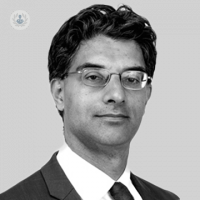Stem cells and anti-VEGF injections to treat age-related macular degeneration
Escrito por:Stem cells, anti-VEGF injections and complement inhibitor drugs are among the most promising options for the treatment of age-related macular degeneration (AMD).
Here to talk about the newest treatments currently underway for curing this retina disorder is Professor Adnan Tufail, leading ophthalmologist and research lead at the world-renowned Moorfields Eye Hospital for AMD.

What is AMD and what is the current most common treatment for it?
Age-related macular degeneration (AMD) is a condition that affects the centre of the back of the eye, where the cells that pick up light are most closely packed together to give high resolution vision. This area is called the macula, that is important for reading and fine vision.
In this condition, In the commonest form, the macula develops waste build up under the centre, called early dry macular degeneration. If we all live long enough, the waste build-up can cause worn out patches in the macula, called late dry or atrophic macular degeneration. In addition to this underlying process, some eyes – but not all - can develop a sudden growth of blood vessels in the macula that can leak and bleed. This is called wet macular degeneration because the blood vessels leak fluid and cause swelling that make the macular. This can cause a sudden drop in vision.
For the wet form of macular degeneration, we have some reasonably effective treatments which are medicines we put inside the eye, that block the growth of blood vessels. We don't have proven treatments yet, but we are close to some treatments for advanced dry macular degeneration.
Stem cells are becoming more used in medicine. How exactly is stem cell treatment used for AMD?
Stem cells are a very exciting potential treatment in the future for AMD. We know that the cells under the back of the eye - like the brain - later in life cannot heal or repair themselves.
With late dry AMD and certain aggressive forms of wet AMD, we don't have established treatments. The hope is that, with special surgical techniques, we will be able to deliver and replace the damaged or lost cells in the macula with normal cells. At this point in time, the only trials available can only replace one type of cell called the pigment epithelial cells, but not the other types of cells that are often damaged as well. To get these cells into the correct location requires a surgical procedure.
At this point in time, stem cells are only available in research trials to very specific forms of AMD, and not all forms. We hope with further developments this can be a clinically useful treatment.
Some doctors are treating AMD with laser. Can you explain this newer treatment in more detail?
There are a number of different laser treatments that have been used for the last 30 years for age-related macular degeneration.
Before we developed the injection treatment that stops blood vessels leaguing for wet macular degeneration (“anti-VEGF” injections), we had thermal laser treatment. Thermal laser treatment - which is destructive - has been replaced by the injection treatments for wet AMD. However, there are some forms of wet AMD called polypoidal lesions, that are more common in southeast Asia that can be managed in conjunction with injections with a form of laser called photodynamic therapy. Photodynamic therapy involves an infusion of a medicine in the arm that makes the leaky vessels in the eye very sensitive to light, and then a very low powered special type of laser is targeted at the polypoidal lesions that reacts with the drugs, closing the leaky vessels down. The polypoidal form of wet AMD occurs in the Western countries as well, where thermal laser or photodynamic therapy, may be an effective treatment choice.
In addition to those treatments, there are some other forms of laser that may have potential to help patients with forms of dry macular degeneration. The two forms of laser are photo biomodulation, and a very short duration laser pulse that is less destructive to the back of the eye.
The photo biomodulation is the application to the macula of a very specific wavelength of light that. Photo biomodulation has been used in various studies for 50 years. In animal models and laboratory work, this application of specific light wavelengths seems to affect the way the cells in the back of the eye function. However, as of yet, we don't have robust trials to say whether they definitely prevent visual loss in the medium to long-term for the patients, or not from the onset of late AMD.
Therefore, although there are encouraging results and interesting lab work, it's not something we can definitely recommend for all patients. Another form of laser is the very short wavelength light type of laser (nano pulse laser), which has gone through some really robust trials from our colleagues in Australia that overall showed no benefit. Although, it may be that certain types of dry macular degeneration may benefit, provided they don't have particular forms of dry AMD, called reticular pseudodrusen. Further trials may help define this better before this can become a recommended treatment.
Has there been any progress on eye drops as a treatment method for AMD? Why or why not?
There have been a number of trials to try and deliver drugs to the back of the eye using drops. Part of the problem is trying to get a good enough dose from a drop in high enough concentration to the macula, as the drug has to either pass through the structures inside the eye or travel around the outside of the eye and then penetrate the macula.
There have been a number of trials of drops that may reduce or partially replace the need for injections, but as of today we haven't had success. However, there will be further ongoing trials to achieve this.
Which new treatments would you say is the biggest breakthrough for treating AMD?
We have two new treatments that have either just been licensed or hopefully will be licensed by the end of the year. The first is a new drug to treat wet AMD called faricimab, that is the first injectable treatment that goes beyond simply blocking vascular endothelial growth factor (VEGF), which is a chemical released in the macula that makes abnormal blood vessels leak and grow. This new drug blocks two types of chemicals that can cause blood vessel growth.
The research trials show a slightly improved benefit in terms of longer duration and conventional treatments, but not necessarily a better outcome. However, given that most of the reasons we don't get great outcomes in our patients is the burden of treatment and the frequency of treatment, I'm hopeful that the introduction of this new drug will lead to better outcomes for patients in the real world.
The second ray of hope is the results of clinical trials for the first drug that shows potential benefits for preventing late dry macular degeneration from getting worse. These are called complement inhibitor drugs, that can slow down the enlargement of the worn-out patch. The results of a phase three trial from a drug from a company called Apellis, was positive in one trial and positive when both trials were combined, so we are hoping these results will lead to approval of that drug by the end of this year. There is another complement inhibitor drug from Iveric Bio that will finish its final clinical studies within the next few months that is also exciting.
There are drugs from other companies in phase three trials, blocking other parts of the immune system, so there could be a major breakthrough. We also have hopes for an approved drug in the next 12 months to treat a - currently untreatable - blinding form of AMD called advanced dry or atrophic macular degeneration.
Professor Adnan Tufail is a highly esteemed leading ophthalmologist based in London, who specialises in medical retina disorders and novel drug and cell therapies. If you’re suffering from AMD, or simply wish to know more about the latest treatments for retina disorders, make sure to visit Professor Tufail’s Top Doctors profile today.


